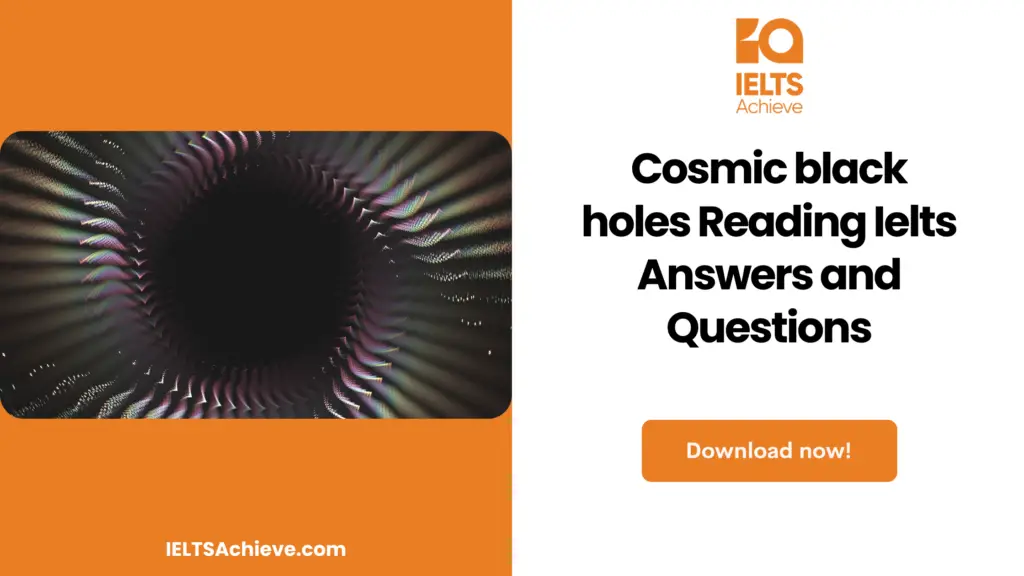The Blog post contains the following IELTS Reading Questions
- IELTS Reading sentence completion
- IELTS Reading multiple choice questions
- IELTS Reading True, false or not given
Stay informed and prepared for success – Explore our comprehensive Reading Test Info page to get valuable insights, exam format details, and expert tips for mastering the IELTS Reading section.
IELTS Reading Passage – Cosmic black holes

Cosmic Black Hole
In 1687, the English scientist Isaac Newton published his monumental work, Philosophiae Naturalis Principia Mathematica (Mathematical Principles of Natural Philosophy), containing his theory of gravitation and the mathematics to support it. in essence, Newton’s law of gravitation stated that the gravitational force between two objects, for example, two astronomical bodies, is directly proportional to their masses. Astronomers found that it accurately predicted all the observable data that science at that time was able to collect, with one exception- a very slight variation in the orbit of the planet Mercury around the sun. It was 228 years before anyone was able to offer a refinement of Newton’s law that accounted for the shape of Mercury’s orbit. In 1915, Albert Einstein’s general theory of relativity was published. Using the equations of general relativity, he calculated the shape of Mercury’s orbit. The results predicted astronomical observations exactly and provided the first proof of his theory. Expressing it very simplistically, the general theory of relativity presumes that both matter and energy can distort space-time and cause it to curve. What we commonly call gravity is in fact the effect of that curvature.
Among other phenomena, Einstein’s theory predicted the existence of black holes, although initially, he had doubts about their existence. Black holes are areas in space where the gravitational field is so strong that nothing can escape them. Because of the immense gravitational pull, they consume all the light that comes near them, and thus they are black.” in fact, neither emitting nor reflecting light, they are invisible. Due to this, they can be studied only by inference based on observations of their effect on the matter- both stars and Gasses- around them and by computer simulation. In particular, when gases are being pulled into a black hole, they can reach temperatures up to 1,000 times the heat of the sun and becomes an intensely glowing source of X rays Surrounding each black hole is an “event horizon,” which defines the area over which the gravitational force of the black hole operates. Anything passing over the lip of the event horizon is pulled into the black hole. Because observations of event horizons are difficult due to their relatively small size, even less is known about them than about black holes themselves. Black holes exist in three sizes. Compact ones, called star-mass black holes and which have been known to exist for some time, are believed to be the result of the death of a single star. When a star has consumed itself to the point that it no longer has the energy to support its mass, the core collapses and forms a black hole. Shock waves then bounce out, causing the shell of the star to explode. In a way that is not yet understood, the black hole may then reeneffize and create multiple explosions within the first few minutes of its existence. So-called supermassive black holes, also well documented, contain the mass of millions or even billions of stars. And just recently one intermediate black hole, with about 500 times the mass of the sun, has been discovered. Scientists have postulated that the intermediate black hole may provide a “missing link in understanding the evolution of black holes.
Current scientific data suggest that black holes are fairly common and lie at the center of most galaxies. Based on indirect evidence gained using X-ray telescopes, thousands of black holeshave been located in our galaxy and beyond. The blagk hole at the center of the Milky Way, known as Sagittarius A* (pronounced “A-star*), is a supermassive one, containing roughly four million times the mass of our sun. Astronomers suggest that orbiting around Sagittarius A*, 26,000 light-years from Earth, maybe as many as tens of thousands of smaller black holes. One possible theory to explain this is that a process called dynamical friction” is causing stellar black holes to sink toward the center of the galaxy. It is thought that the first black holes came into existence not long after the big bang. Newly created clouds of gases slowly coalesced into the first stars. As these early stars collapsed, they gave rise to the first black holes. A number of theories proposed that the first black holes were essential “seeds,” which then gravitationally attracted and consumed enormous quantities of matter found in adjacent gas clouds and dust. This allowed them to grow into the supermassive black holes that now sit in the centers of galaxies. However, a new computer simulation proposes that such growth was minimal. When the simulated star collapsed and formed a black hole, there was very little matter anywhere near the black hole’s event horizon. Being in essence “starved,” it grew by less than 1 percent over the course of its first hundred million years. The new simulations do not definitively invalidate the seed theory, but they make it far less likely. On the other hand, it is known that black holes existed a billion times more massive than our sun did exist in the early universe. Researchers have yet to discover how these supermassive black holes were formed in such a short time, and the origin of these giants poses one of the most fundamental questions in astrophysics. It has become practically a hallmark of the research on black holes that with each new study. more is known, more theories are generated, and yet more questions are raised than answered
Unlock your full potential in the IELTS Reading section – Visit our IELTS Reading Practice Question Answer page now!
Recommended Questions:
Renewable Energy IELTS Reading Question with Answer
Cosmic black holes Reading Questions
Questions 1-7
Complete each sentence with the correct ending, A—N, below.
Write the correct letter, A —N, on lines 1-7 on your answer sheet.
1.Newton’s law of gravitation
2.Einstein’s theory of relativity
3.We define black holes as areas that have
4.Scientists study black holes
5.Gases that are pulled into a black hole
6.Event horizons are
7.Compact black holes occur
A by observing the matter around them.
B suggested the presence of black holes in outer space.
C when a single star collapses.
1.difficult to study.
2.barely visible light.eins
3.an inescapable gravitational pull.
4.did not apply to most astronomical bodies.
5.by direct observation.
6.Could not explain Mercury’s path around the sun.
7.caused doubt about the existence of black holes.
8.lose visibility.9.become very hot.
10.with large event horizons.
11.at the center of each black hole.
Enhance your sentence completion skills in the IELTS Reading section. Click here to access our comprehensive guide and learn effective strategies for filling in missing words or phrases in sentences.
Questions 8 and 9
Choose the correct letter, A, B, or C, in boxes 8 and 9 on your answer sheet.
8.Black holes can be found
1.only in the Milky Way.
2.in most galaxies.
3.close to the sun.
9. Sagittarius A* is
1.a black hole located 26,000 light-years from Earth.
2.one of the thousands of black holes orbiting Earth.
3.a well-known compact black hole.
Ready to improve your performance in Multiple Choice Questions (MCQs)? Click here to access our comprehensive guide on how to tackle MCQs effectively in the IELTS Reading section.
Questions 10-13
Do the following statements agree with the information given in the passage?
On lines 10—13 on your answer sheet, write:
TRUE: if the statement agrees with the information
FALSE: if the statement contradicts the information
NOT GIVEN: If there is no information on this in the passage
10. It is not certain when the big bang occurred.
11. According to the “seed” theory, the first black holes eventually became supermassive black holes.
12. The “seed” theory has been proven true by computer simulation.
13. The black holes that existed in the early universe were all compact black holes.
Enhance your skills in identifying information as True, False, or Not Given. Click here to discover expert strategies and techniques for mastering this question type in the IELTS Reading section.
Unlock your full potential in the IELTS Reading section – Visit our IELTS Reading Practice Question Answer page now!
Recommended Questions:
Renewable Energy IELTS Reading Question with Answer
Cosmic black holes Reading Answers
1.Answer: I
2.Answer: B
3.Answer: F
4.Answer: A
5.Answer: L
6.Answer: D
7.Answer: C
8.Answer: B
9.Answer: A
10.Answer: NOT GIVEN
11.Answer: TRUE
12.Answer: FASLE
13.Answer: FALSE

We hope you found this post useful in helping you to study for the IELTS Test. If you have any questions please let us know in the comments below or on the Facebook page.
The best way to keep up to date with posts like this is to like us on Facebook, then follow us on Instagram and Pinterest. If you need help preparing for the IELTS Test, join the IELTS Achieve Academy and see how we can assist you to achieve your desired band score. We offer an essay correction service, mock exams and online courses.

